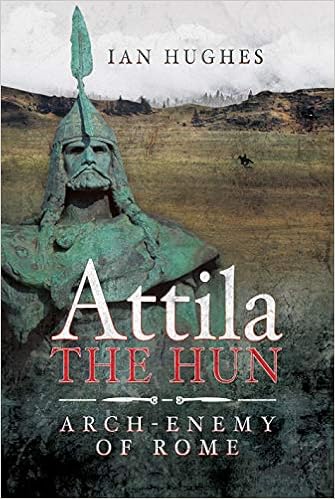The Battle of Thatis River
By John Patrick Hewson
In the second half of the sixth century BC a large scale tribal movement took place north of the Black sea. This began when the Massagetai, the largest and most powerful of the tribes of north Central Asia, undertook an aggressive expansion into the steppes of Kazakhstan. During this process they either enslaved or integrated into their horde many of the nomadic horse tribes of central Asia. We know very little about the resulting confederation except that its success was due in part to the development of a new form of elite heavy cavalry known to the Greeks as Kataphraktoi, which became what we know as Cataphracts.
However, not all of the Central Asian horse tribes accepted the domination of the Massagetai. Some of these fled westward into the territories of the Sauromatians, another powerful horse tribe. Here, they formed a system of alliances which evolved into the tribal confederation known as the Sarmatians. But rapid population growth and the consequent need for greater food supplies drove some of the Sarmatians further west across the river Don into the lands of the Scythians. As a result, the Scythians, unable to withstand the sudden influx of large numbers of Sarmatians, began to push into the Bosporus. Here they lived peacefully within the Greek city states.
The peace lasted until 309 BC, when Parysadas, the king of the Greek city states of the Bosporus, died, leaving as his heirs three sons, Satyrus, Eumelus and Prytanis.[1] Satyrus, the eldest, made an alliance with Prytanis, the youngest, in order to reaffirm his claim to the kingship. This caused Eumelus, the second son, who felt he had an equal right to the kingship, to make an alliance with Aripharnas, the king of the Sarmatians and threaten Satyrus. Satyrus immediately made an alliance with the Scythians against their old enemies the Sarmatians, now under joint command of Aripharnas and Eumelus.
Satyrus raised a Bosporan composite army of 2000 Greeks, an equal number of Thracian peltasts and 30,000 Scythian allies, of which 10,000 were mounted. The Greeks fought as mounted phalanx, and their contingent, which also included mercenaries from as far away as Sparta, Cyprus and Syracuse, carried composite bow and lance and wore bronze armour. The Thracian peltasts, light infantry intended as skirmishing troops, carried the pelte, a crescent-shaped shield of wicker covered with sheep or goat skins. Their offensive weapon was a medium length thrusting spear and they wore armour of reinforced heavy linen. The Scythain rank and file fought as horse archers, but their wealthy tribal princes and their bodyguards fought as heavy cavalry in close order wedge formation. Their job was to cut through the enemy’s main battle line after it had been weakened by fire from the horse archers. They wore a corselet of bronze or iron scale armour based on the Assyrian design, with the scales overlapping in three layers so that they could not be penetrated by just a single blow from an enemy heavy sword or battle axe. Their helmets were of Attic Greek design, and their major offensive weapon was the heavy composite bow, which they loaded with heavy iron arrows having three pronged barbed arrowheads. We know little about the Sarmatian army, except that it was larger than the Bosporan, consisting of 20,000 horse and at least 22,000 foot, raised by tribal levy.
Leaving Prytanis to guard his capital of Panticeperm, Satyrus departed. As his army marched in column through the steppes, his scouts spotted the Sarmatians encamped on the river Thatis, a tributary of the Kuban. Satyrus made the dangerous decision to cross the river immediately and destroy the Sarmatians in a single large battle. His soldiers began to ford the Thatis, together with the long baggage train; a slow and difficult manoeuvre. The Sarmatians, watching them cross, could have descended upon them in strength and badly mauled them as they were in the process of crossing, but for some inexplicable reason they chose not to do so. Perhaps they were counting on their much larger army to defeat the Bosporans in a pitched battle.
After the crossing, Satyrus halted his army on the eastern bank of the river. There, they camped within a circle made by the baggage carts, a traditional steppe nomad method probably suggested to him by the Scythains. The next morning both armies came out of their camps and prepared for battle. Satyrus deployed with the Scythian heavy cavalry in the centre under his direct command, with the Greeks and Thracians on the right and the Scythian infantry on the left. Eumelus commanded a contingent of Sarmatian infantry, which he deployed on the left of his line, facing the Greeks and Thracians. On the right, facing the Scythian infantry, he deployed the remainder of the Sarmatian infantry under Aripharnas. In the centre, facing the vaunted Scythian heavy cavalry he deployed his Sarmatian heavy cavalry.
The battle opened with volleys of arrows being fired and javelins being hurled back and forth. Then the heavy cavalries in the centre charged each other with thundering impact, and Satyrus, protected by his personal bodyguard, attempted to reach Ariphanas, whom he wanted to engage in personal combat. However, this duel never took place, and Satyrus and his bodyguard became engaged in heavy fighting with the Sarmatian cavalry. The opposing wings then clashed. The Scythian infantry on Satyrus’s left hurled itself at the Sarmatian night but were unable to break their line, resulting in fierce and bloody inconclusive fighting. On Satyrus’s right the Greeks advanced slowly under a rain of arrows, the Thracian peltasts being unable to provide effective missile support because of their lack of numbers.
Meanwhile the cavalry fight in the centre continued to rage with heavy losses on both sides. After a while, however, the greater numbers of the Scythian cavalry began to tell and the Sarmatian cavalry was routed. On Satyrus’s right, however, Eumelus’s Sarmatian infantry drove the Greeks back, and when Satyrus received this news he broke off his centre attack and wheeled his cavalry right to attack Eumelus from the rear. At the sight of their left collapsing, the Sarmatian right, which was still fighting, retreated and were pursued by the Scythian infantry.
But, in spite of Satyrus’s apparent victory on the battlefield, both Eumelus and Ariphanas managed to escape with contingents of warriors. They took refuge in a fortress on an island in the middle of the Thatis. It was a formidable fortress; not only surrounded by deep water, but built atop a high cliff surrounded by thick forest, and the main gate was protected by two massive towers and a high and thick defensive wall. The other side of the island was a deep swamp, which made attack by heavily armed men impossible.
Satyrus decided to attack the main gate. The result of the initial attack was a disaster, with the Bosporans suffering heavy casualties and being forced to retreat. Satyrus then decided to attack through the swamp, which was protected by a high wooden palisade. His forces managed to break through the palisade but then had to get through the dense forest and thick undergrowth to reach the fortress. The soldiers began to cut down the trees under fire from the archers on the fortress’s battlements. This went on for three days and on the fourth day they stormed the walls. Meniscus, commander of the Greeks, attempted to scale the walls with a detachment of picked men, but the Sarmatian defenders showered them with arrows and spears. Satyrus, seeing this, rushed to Meniscus’s aid with a large force of Scythian heavy infantry, but he was wounded several times in the fighting and the operation had to be suspended. That night he died of his wounds.
This left Meniscus in total command. He decided to suspend the siege due to both the difficulty of storming the walls and the decline of morale due to Satyrus’s death. He withdrew to the village of Gargaza. Satyrus’s body was sent back to Prytanis.
Eumelus, meanwhile, realizing that his fortunes had changed, started peace talks with Prytanis. He proposed to divide the kingdom between them but Prytanis refused, so Eumelus renewed hostilities. He first took Gargaza after a brief fight and then marched on Panticeperm with the entire Sarmatian army. Prytanis was defeated and, against all odds, Eumelus became king of the Bosporus.
| * * * |
Footnotes
[1]. Parysadas had ruled since 347 when he had assumed the throne upon the death of his elder brother Spartocus II.
| * * * |
© 2025 John Hewson
John Harris and Richard Wilbourn have just completed their fifth book in 25 years on the Hess affair, Rudolf Hess: Treachery and Deception.(Jema Publications). The article comes from this new work. John Harris (57) is a Chartered Accountant and Richard Wilbourn (56) a Farms manager. Their research has taken them to five continents and believe this latest research to be fundamental in understanding the Hess affair.
* Views expressed by contributors are their own and do not necessarily represent those of MilitaryHistoryOnline.com.



